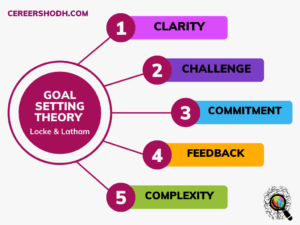Goal setting theory of motivation is the one of most used process theory of motivation in all the organizations or companies. The theory developed by Edwin Locke & Gary Latham in the 1960s and 1970s. It shows that setting specific and challenging goals can significantly enhance an individual’s motivation and performance in various tasks.
What is Motivation?
- The term ‘motivation’ -Latin word- ‘movere’ –‘to move‘.
- We all know about the motive power or an automotive (self – moving) vehicle.
- The mechanism of motivation – movement towards a desire object.
Motivation is-
- Logical scientific construct.
- No immediate sensory testimony/ proof.
- A hypothetical process, the functioning of which is inferred from observations of the behavior.
- Like gravity / intelligence etc
Definitions of Motivation
Motivation is defined as a hypothetical process inferred from certain changes in responses taking place as a consequence of certain changes in the stimulus .
Motivation involves forces which mobilise activities of the individual and channelise them in those directions which help in accomplishing goals.
Motivation consists of the motivators which energise, activate, move, direct and channel an individual’s behaviour towards certain goals.
Hodge and Johnson observe, Motivation in organisational settings refers to the willingness of an individual to react to organisational requirements in the short run. The more positive is the motivation of an individual towards the institution, S/he will perform effectively.
Locke & Latham defined work motivation as the internal force that drives a worker to action as well as the external factors that encourage that action.
Process theories of Motivation
Process theories explain how workers select behavioural actions to meet their needs and determines their choices.
The Process theories offer advice and insight on
- How people actually make choices to work hard or not work hard,
- based on their individual performances,
- the available rewards and the possible work outcomes.
There are four main theories come in process theories of motivations-
- Adam’s Equity theory,
- Vroom’s Expectancy theory,
- Thorndike’s Reinforcement theory,
- Locke’s Goal-setting theory.
Goal Setting Theory of Motivation- Locke & Latham
Edwin Locke (1968) published his groundbreaking Goal Setting Theory in ‘Toward a Theory of Task Motivation and Incentive’.
How to set the effective goals on subsequent performance.
Locke’s primary revelation was around the power of setting specific and measurable goals, rather than keeping outcomes general. With his theory he demonstrated how targets like “increase sales by 20%”etc are much more effective than vague direction such as “complete your work to a higher standard”.
Components of Goal Setting Theory of Motivation

Goal-Setting-Theory-of-Motivation- by Locke&Latham
Locke and Latham’s five principles of effective goal setting-
1.Clarity.
A goal must be specific and clear. Goals should be clear, well-defined, and easily measurable, leaving no room for ambiguity. Specific goals provide a clear direction for the individual to follow.
2.Challenge.
An easy or tedious goal is demotivating.
But keep a realistic balance: don’t expect anyone on your team to spin straw into gold.
Goals that are moderately difficult but attainable can stimulate individuals to put in more effort and perform better than if the goals were too easy or too difficult.
3.Commitment.
Your employees have to understand and buy in to the goal from the outset.
Individuals must be committed to achieving the goals they set. Commitment ensures that they are willing to invest the necessary time and effort to achieve their objectives.
4.Feedback.
Provide regular feedback throughout the whole process. This helps to keep the goal on track.
Regular feedback on progress toward the goal is essential. Feedback helps individuals monitor their performance, make necessary adjustments, and stay on track.
5.Task complexity.
Think about realistic timescales, and break down the process into sub-goals with regular reviews.
The level of complexity of a task can influence the effectiveness of goal setting. For simple and routine tasks, specific goals work well, but for complex and creative tasks, a more flexible approach may be necessary.
Locke and Latham’s (1990) found in a comprehensive meta-analysis of more than 35 years of research on goal setting, that a strong positive relationship between specific, challenging goals and performance. The study concluded that setting specific and difficult goals led to higher levels of task performance compared to easy or no goals.
References for Goal setting theory of motivation
1. Newstrom, J.W.(2007) Organizational behaviour : Human behaviour at work N.D.: Tata McGraw-Hill
2. Greenberg, J. and Baron R.A. (2005) Behaviour in organizations. N.D.: Pearson Edu.
3. Luthans, F. (2013) Organizational behaviour: An Evidence – based Approach (12thEd.) ND : McGraw-Hill Edu (India) Pvt. Ltd.
4. Robbins, S.P., Judge T.A., & Sanghi, A. (2009) Organizational behaviour N.D. Pearson Prentice Hall.
Subscribe to Careershodh
Get the latest updates and insights.
Join 14,333 other subscribers!
Niwlikar, B. A. (2023, August 2). Goal Setting Theory of Motivation & its Components. Careershodh. https://www.careershodh.com/goal-setting-theory/
